Quality Management and Leadership Principles
VerifiedAdded on 2020/10/23
|18
|5968
|289
AI Summary
This assignment is focused on exploring the principles of quality management and leadership. It requires analyzing various sources to understand how quality management can be implemented in organizations for operational excellence. The student needs to hire skilled labor, provide equivalent pay to customers, and frame a better working environment. The assignment also covers situational leadership, its flexibility, and how it leads to success.
Contribute Materials
Your contribution can guide someone’s learning journey. Share your
documents today.
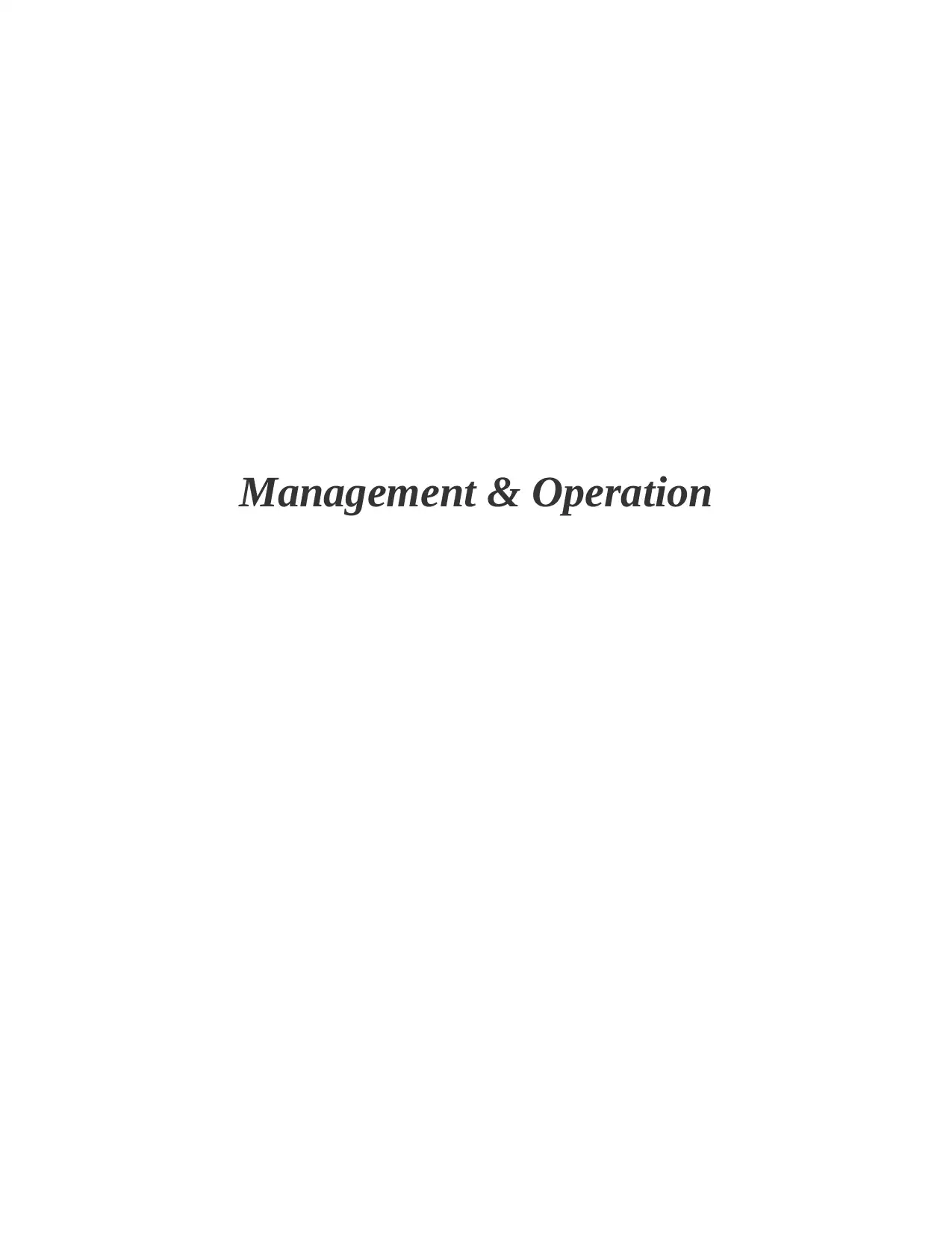
Management & Operation
Secure Best Marks with AI Grader
Need help grading? Try our AI Grader for instant feedback on your assignments.
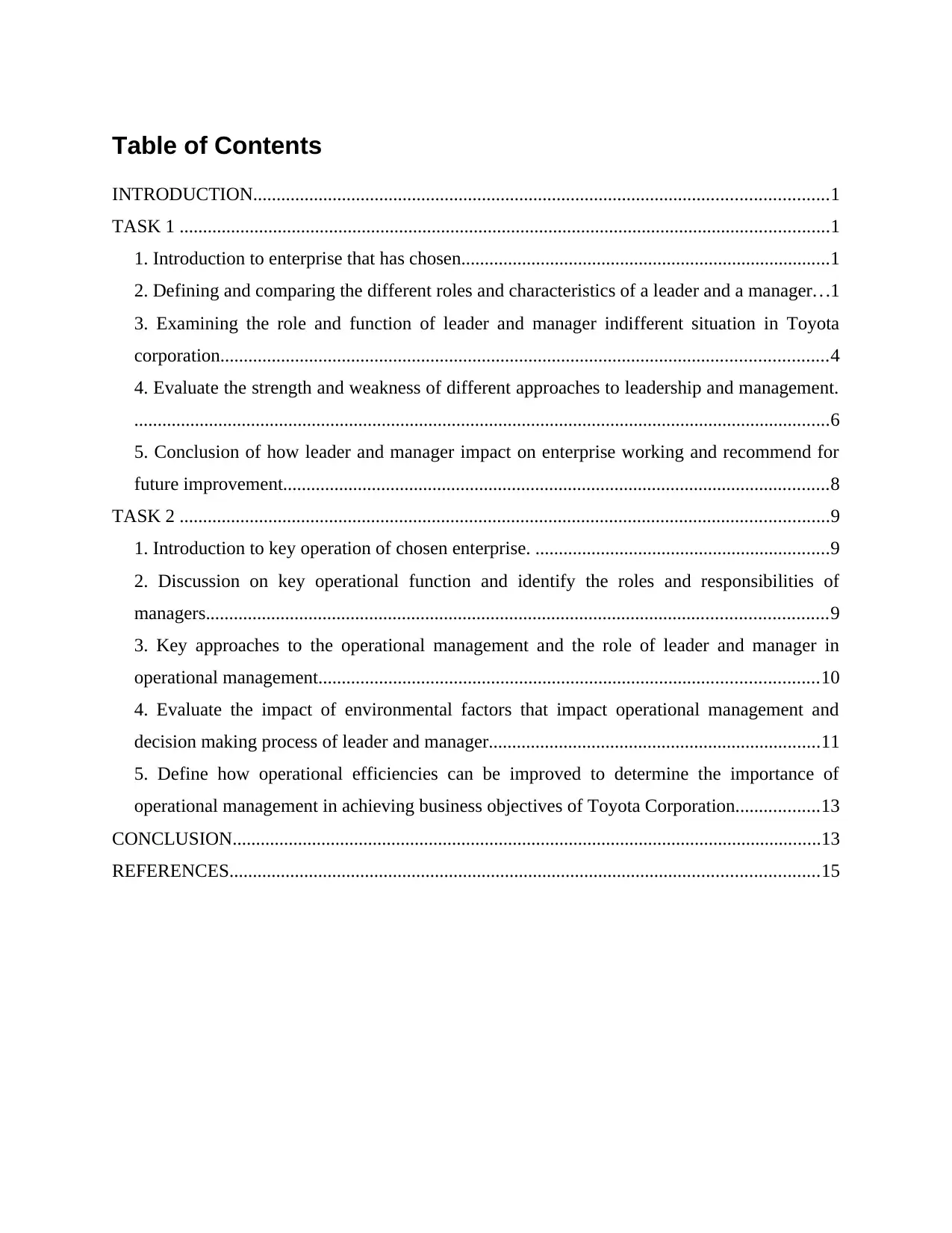
Table of Contents
INTRODUCTION...........................................................................................................................1
TASK 1 ...........................................................................................................................................1
1. Introduction to enterprise that has chosen...............................................................................1
2. Defining and comparing the different roles and characteristics of a leader and a manager.. .1
3. Examining the role and function of leader and manager indifferent situation in Toyota
corporation..................................................................................................................................4
4. Evaluate the strength and weakness of different approaches to leadership and management.
.....................................................................................................................................................6
5. Conclusion of how leader and manager impact on enterprise working and recommend for
future improvement.....................................................................................................................8
TASK 2 ...........................................................................................................................................9
1. Introduction to key operation of chosen enterprise. ...............................................................9
2. Discussion on key operational function and identify the roles and responsibilities of
managers.....................................................................................................................................9
3. Key approaches to the operational management and the role of leader and manager in
operational management...........................................................................................................10
4. Evaluate the impact of environmental factors that impact operational management and
decision making process of leader and manager.......................................................................11
5. Define how operational efficiencies can be improved to determine the importance of
operational management in achieving business objectives of Toyota Corporation..................13
CONCLUSION..............................................................................................................................13
REFERENCES..............................................................................................................................15
INTRODUCTION...........................................................................................................................1
TASK 1 ...........................................................................................................................................1
1. Introduction to enterprise that has chosen...............................................................................1
2. Defining and comparing the different roles and characteristics of a leader and a manager.. .1
3. Examining the role and function of leader and manager indifferent situation in Toyota
corporation..................................................................................................................................4
4. Evaluate the strength and weakness of different approaches to leadership and management.
.....................................................................................................................................................6
5. Conclusion of how leader and manager impact on enterprise working and recommend for
future improvement.....................................................................................................................8
TASK 2 ...........................................................................................................................................9
1. Introduction to key operation of chosen enterprise. ...............................................................9
2. Discussion on key operational function and identify the roles and responsibilities of
managers.....................................................................................................................................9
3. Key approaches to the operational management and the role of leader and manager in
operational management...........................................................................................................10
4. Evaluate the impact of environmental factors that impact operational management and
decision making process of leader and manager.......................................................................11
5. Define how operational efficiencies can be improved to determine the importance of
operational management in achieving business objectives of Toyota Corporation..................13
CONCLUSION..............................................................................................................................13
REFERENCES..............................................................................................................................15
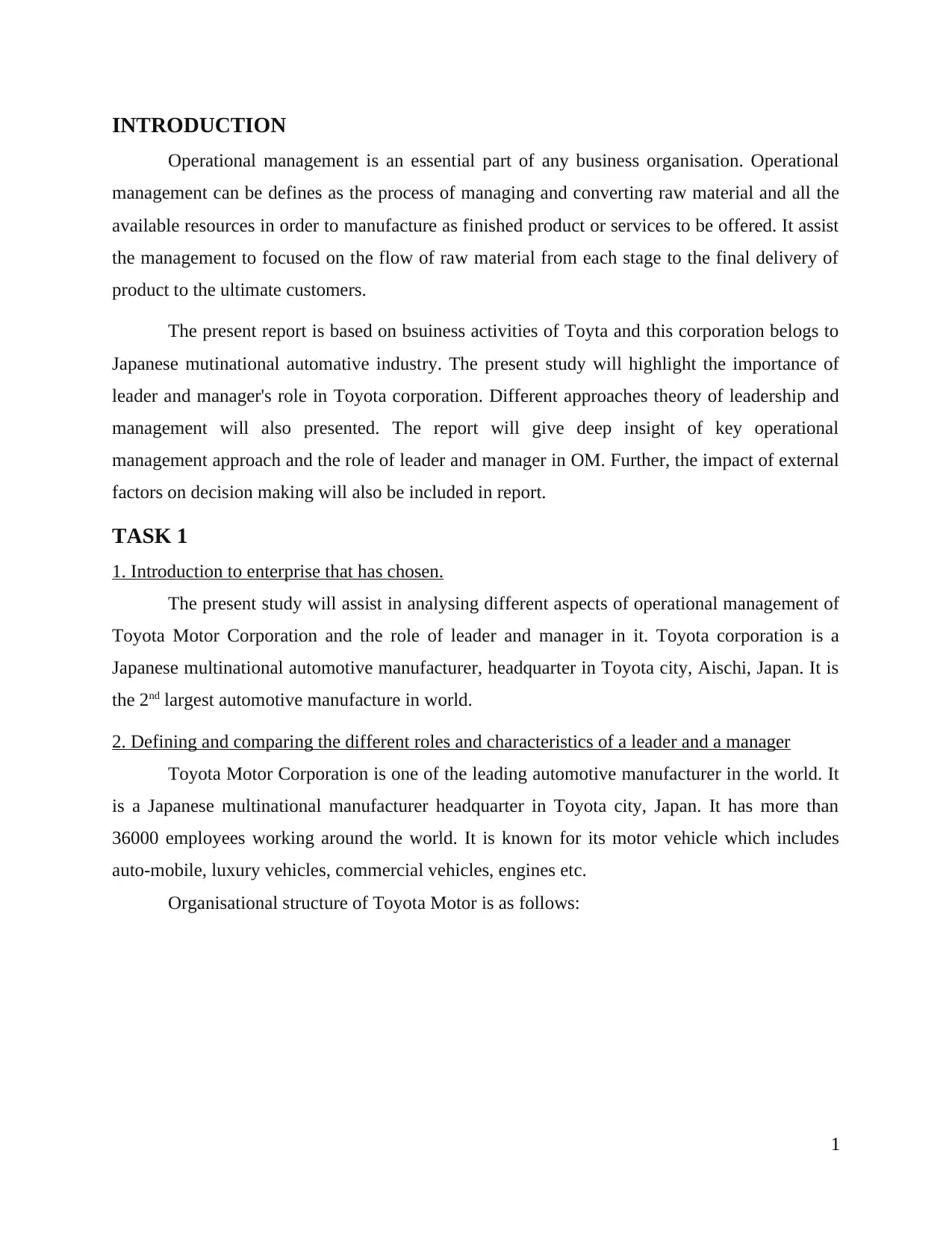
INTRODUCTION
Operational management is an essential part of any business organisation. Operational
management can be defines as the process of managing and converting raw material and all the
available resources in order to manufacture as finished product or services to be offered. It assist
the management to focused on the flow of raw material from each stage to the final delivery of
product to the ultimate customers.
The present report is based on bsuiness activities of Toyta and this corporation belogs to
Japanese mutinational automative industry. The present study will highlight the importance of
leader and manager's role in Toyota corporation. Different approaches theory of leadership and
management will also presented. The report will give deep insight of key operational
management approach and the role of leader and manager in OM. Further, the impact of external
factors on decision making will also be included in report.
TASK 1
1. Introduction to enterprise that has chosen.
The present study will assist in analysing different aspects of operational management of
Toyota Motor Corporation and the role of leader and manager in it. Toyota corporation is a
Japanese multinational automotive manufacturer, headquarter in Toyota city, Aischi, Japan. It is
the 2nd largest automotive manufacture in world.
2. Defining and comparing the different roles and characteristics of a leader and a manager
Toyota Motor Corporation is one of the leading automotive manufacturer in the world. It
is a Japanese multinational manufacturer headquarter in Toyota city, Japan. It has more than
36000 employees working around the world. It is known for its motor vehicle which includes
auto-mobile, luxury vehicles, commercial vehicles, engines etc.
Organisational structure of Toyota Motor is as follows:
1
Operational management is an essential part of any business organisation. Operational
management can be defines as the process of managing and converting raw material and all the
available resources in order to manufacture as finished product or services to be offered. It assist
the management to focused on the flow of raw material from each stage to the final delivery of
product to the ultimate customers.
The present report is based on bsuiness activities of Toyta and this corporation belogs to
Japanese mutinational automative industry. The present study will highlight the importance of
leader and manager's role in Toyota corporation. Different approaches theory of leadership and
management will also presented. The report will give deep insight of key operational
management approach and the role of leader and manager in OM. Further, the impact of external
factors on decision making will also be included in report.
TASK 1
1. Introduction to enterprise that has chosen.
The present study will assist in analysing different aspects of operational management of
Toyota Motor Corporation and the role of leader and manager in it. Toyota corporation is a
Japanese multinational automotive manufacturer, headquarter in Toyota city, Aischi, Japan. It is
the 2nd largest automotive manufacture in world.
2. Defining and comparing the different roles and characteristics of a leader and a manager
Toyota Motor Corporation is one of the leading automotive manufacturer in the world. It
is a Japanese multinational manufacturer headquarter in Toyota city, Japan. It has more than
36000 employees working around the world. It is known for its motor vehicle which includes
auto-mobile, luxury vehicles, commercial vehicles, engines etc.
Organisational structure of Toyota Motor is as follows:
1
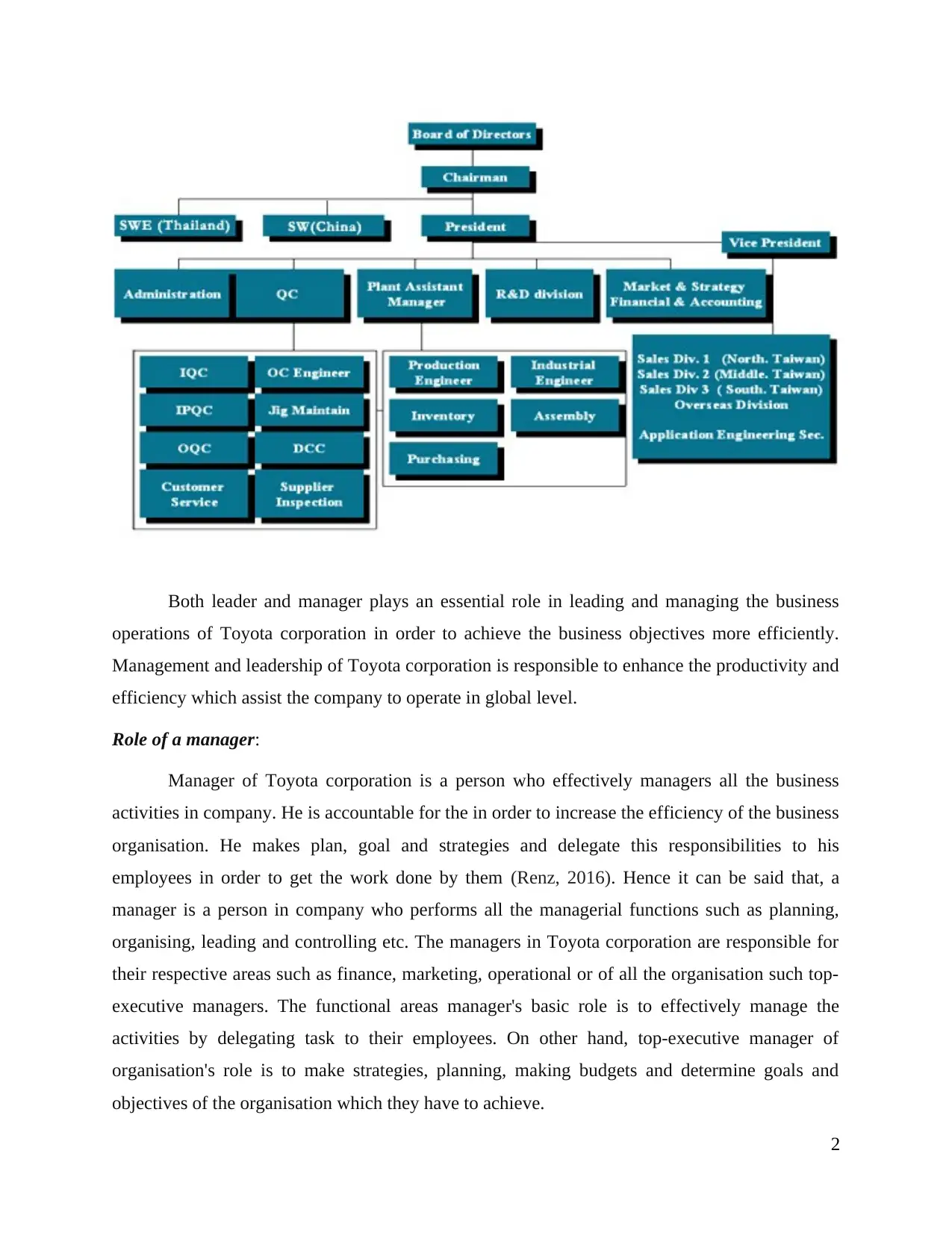
Both leader and manager plays an essential role in leading and managing the business
operations of Toyota corporation in order to achieve the business objectives more efficiently.
Management and leadership of Toyota corporation is responsible to enhance the productivity and
efficiency which assist the company to operate in global level.
Role of a manager:
Manager of Toyota corporation is a person who effectively managers all the business
activities in company. He is accountable for the in order to increase the efficiency of the business
organisation. He makes plan, goal and strategies and delegate this responsibilities to his
employees in order to get the work done by them (Renz, 2016). Hence it can be said that, a
manager is a person in company who performs all the managerial functions such as planning,
organising, leading and controlling etc. The managers in Toyota corporation are responsible for
their respective areas such as finance, marketing, operational or of all the organisation such top-
executive managers. The functional areas manager's basic role is to effectively manage the
activities by delegating task to their employees. On other hand, top-executive manager of
organisation's role is to make strategies, planning, making budgets and determine goals and
objectives of the organisation which they have to achieve.
2
operations of Toyota corporation in order to achieve the business objectives more efficiently.
Management and leadership of Toyota corporation is responsible to enhance the productivity and
efficiency which assist the company to operate in global level.
Role of a manager:
Manager of Toyota corporation is a person who effectively managers all the business
activities in company. He is accountable for the in order to increase the efficiency of the business
organisation. He makes plan, goal and strategies and delegate this responsibilities to his
employees in order to get the work done by them (Renz, 2016). Hence it can be said that, a
manager is a person in company who performs all the managerial functions such as planning,
organising, leading and controlling etc. The managers in Toyota corporation are responsible for
their respective areas such as finance, marketing, operational or of all the organisation such top-
executive managers. The functional areas manager's basic role is to effectively manage the
activities by delegating task to their employees. On other hand, top-executive manager of
organisation's role is to make strategies, planning, making budgets and determine goals and
objectives of the organisation which they have to achieve.
2
Secure Best Marks with AI Grader
Need help grading? Try our AI Grader for instant feedback on your assignments.
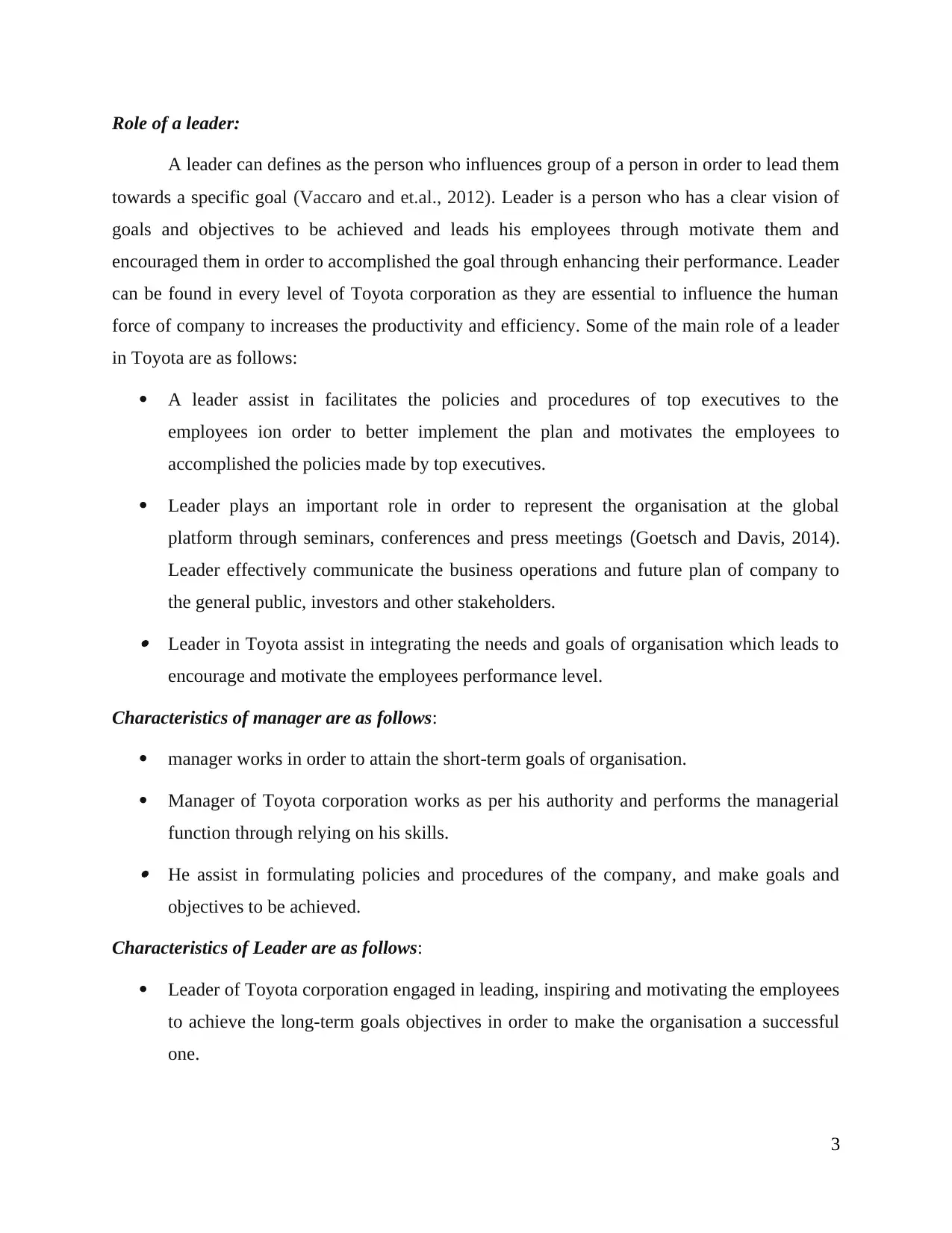
Role of a leader:
A leader can defines as the person who influences group of a person in order to lead them
towards a specific goal (Vaccaro and et.al., 2012). Leader is a person who has a clear vision of
goals and objectives to be achieved and leads his employees through motivate them and
encouraged them in order to accomplished the goal through enhancing their performance. Leader
can be found in every level of Toyota corporation as they are essential to influence the human
force of company to increases the productivity and efficiency. Some of the main role of a leader
in Toyota are as follows:
A leader assist in facilitates the policies and procedures of top executives to the
employees ion order to better implement the plan and motivates the employees to
accomplished the policies made by top executives.
Leader plays an important role in order to represent the organisation at the global
platform through seminars, conferences and press meetings (Goetsch and Davis, 2014).
Leader effectively communicate the business operations and future plan of company to
the general public, investors and other stakeholders. Leader in Toyota assist in integrating the needs and goals of organisation which leads to
encourage and motivate the employees performance level.
Characteristics of manager are as follows:
manager works in order to attain the short-term goals of organisation.
Manager of Toyota corporation works as per his authority and performs the managerial
function through relying on his skills. He assist in formulating policies and procedures of the company, and make goals and
objectives to be achieved.
Characteristics of Leader are as follows:
Leader of Toyota corporation engaged in leading, inspiring and motivating the employees
to achieve the long-term goals objectives in order to make the organisation a successful
one.
3
A leader can defines as the person who influences group of a person in order to lead them
towards a specific goal (Vaccaro and et.al., 2012). Leader is a person who has a clear vision of
goals and objectives to be achieved and leads his employees through motivate them and
encouraged them in order to accomplished the goal through enhancing their performance. Leader
can be found in every level of Toyota corporation as they are essential to influence the human
force of company to increases the productivity and efficiency. Some of the main role of a leader
in Toyota are as follows:
A leader assist in facilitates the policies and procedures of top executives to the
employees ion order to better implement the plan and motivates the employees to
accomplished the policies made by top executives.
Leader plays an important role in order to represent the organisation at the global
platform through seminars, conferences and press meetings (Goetsch and Davis, 2014).
Leader effectively communicate the business operations and future plan of company to
the general public, investors and other stakeholders. Leader in Toyota assist in integrating the needs and goals of organisation which leads to
encourage and motivate the employees performance level.
Characteristics of manager are as follows:
manager works in order to attain the short-term goals of organisation.
Manager of Toyota corporation works as per his authority and performs the managerial
function through relying on his skills. He assist in formulating policies and procedures of the company, and make goals and
objectives to be achieved.
Characteristics of Leader are as follows:
Leader of Toyota corporation engaged in leading, inspiring and motivating the employees
to achieve the long-term goals objectives in order to make the organisation a successful
one.
3
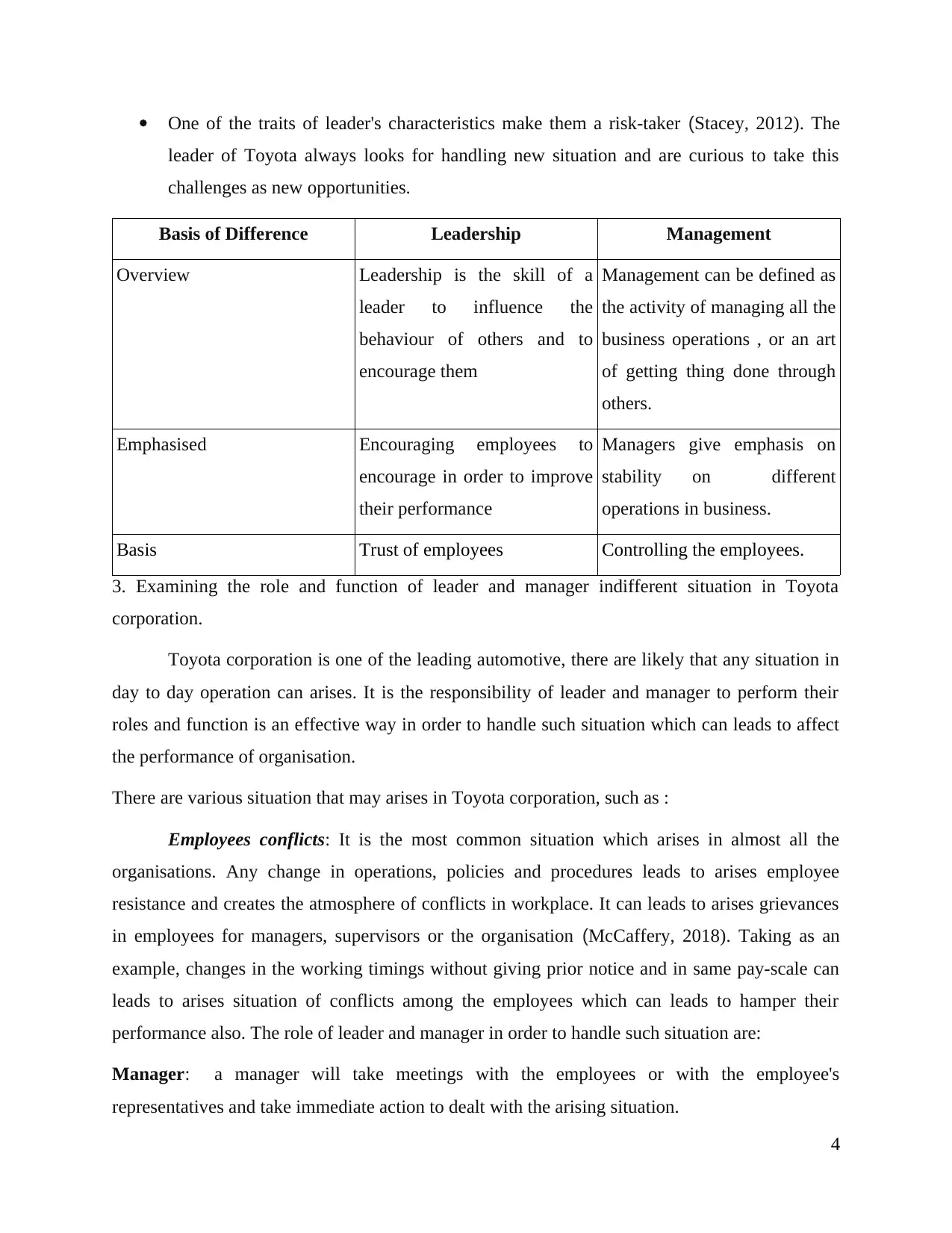
One of the traits of leader's characteristics make them a risk-taker (Stacey, 2012). The
leader of Toyota always looks for handling new situation and are curious to take this
challenges as new opportunities.
Basis of Difference Leadership Management
Overview Leadership is the skill of a
leader to influence the
behaviour of others and to
encourage them
Management can be defined as
the activity of managing all the
business operations , or an art
of getting thing done through
others.
Emphasised Encouraging employees to
encourage in order to improve
their performance
Managers give emphasis on
stability on different
operations in business.
Basis Trust of employees Controlling the employees.
3. Examining the role and function of leader and manager indifferent situation in Toyota
corporation.
Toyota corporation is one of the leading automotive, there are likely that any situation in
day to day operation can arises. It is the responsibility of leader and manager to perform their
roles and function is an effective way in order to handle such situation which can leads to affect
the performance of organisation.
There are various situation that may arises in Toyota corporation, such as :
Employees conflicts: It is the most common situation which arises in almost all the
organisations. Any change in operations, policies and procedures leads to arises employee
resistance and creates the atmosphere of conflicts in workplace. It can leads to arises grievances
in employees for managers, supervisors or the organisation (McCaffery, 2018). Taking as an
example, changes in the working timings without giving prior notice and in same pay-scale can
leads to arises situation of conflicts among the employees which can leads to hamper their
performance also. The role of leader and manager in order to handle such situation are:
Manager: a manager will take meetings with the employees or with the employee's
representatives and take immediate action to dealt with the arising situation.
4
leader of Toyota always looks for handling new situation and are curious to take this
challenges as new opportunities.
Basis of Difference Leadership Management
Overview Leadership is the skill of a
leader to influence the
behaviour of others and to
encourage them
Management can be defined as
the activity of managing all the
business operations , or an art
of getting thing done through
others.
Emphasised Encouraging employees to
encourage in order to improve
their performance
Managers give emphasis on
stability on different
operations in business.
Basis Trust of employees Controlling the employees.
3. Examining the role and function of leader and manager indifferent situation in Toyota
corporation.
Toyota corporation is one of the leading automotive, there are likely that any situation in
day to day operation can arises. It is the responsibility of leader and manager to perform their
roles and function is an effective way in order to handle such situation which can leads to affect
the performance of organisation.
There are various situation that may arises in Toyota corporation, such as :
Employees conflicts: It is the most common situation which arises in almost all the
organisations. Any change in operations, policies and procedures leads to arises employee
resistance and creates the atmosphere of conflicts in workplace. It can leads to arises grievances
in employees for managers, supervisors or the organisation (McCaffery, 2018). Taking as an
example, changes in the working timings without giving prior notice and in same pay-scale can
leads to arises situation of conflicts among the employees which can leads to hamper their
performance also. The role of leader and manager in order to handle such situation are:
Manager: a manager will take meetings with the employees or with the employee's
representatives and take immediate action to dealt with the arising situation.
4
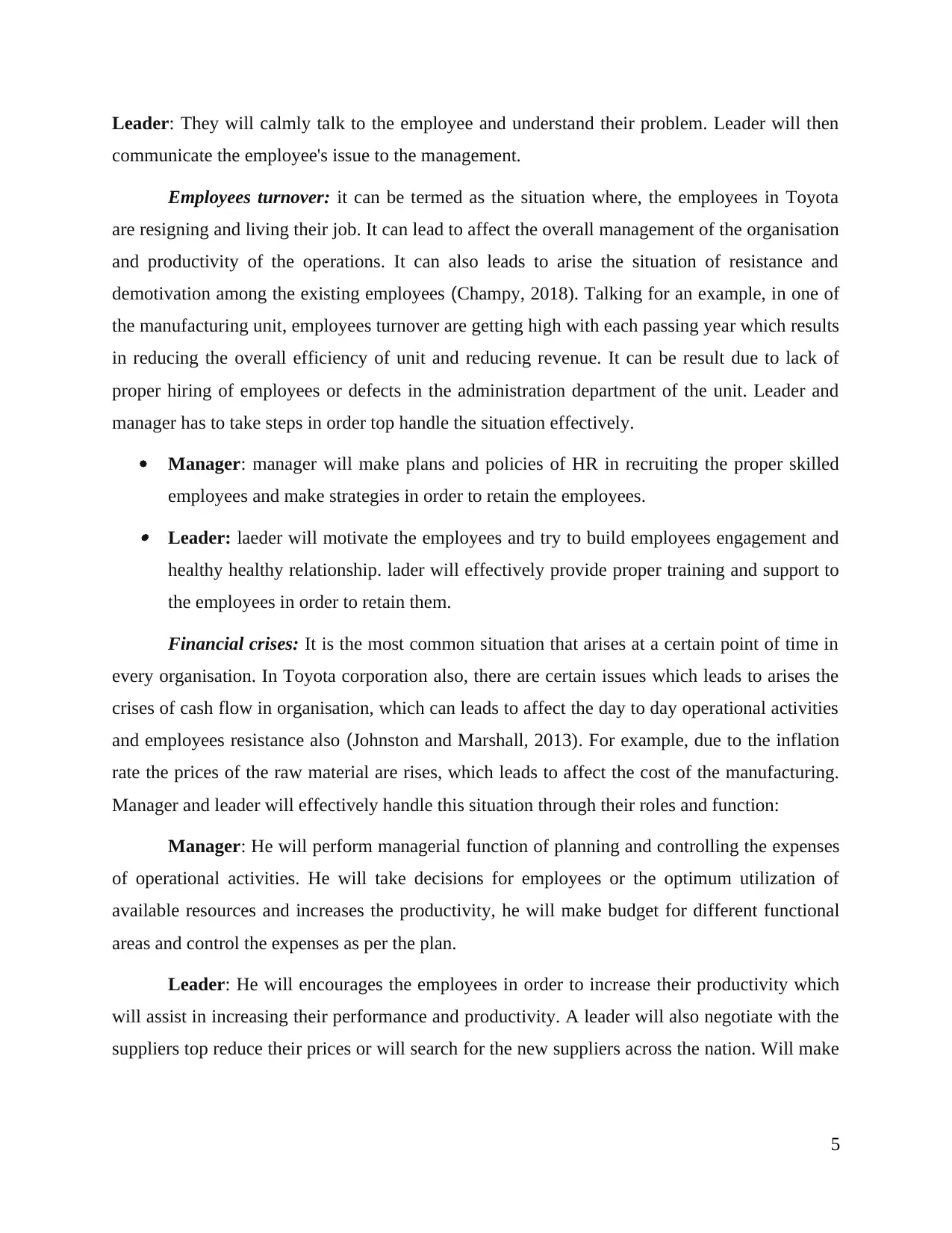
Leader: They will calmly talk to the employee and understand their problem. Leader will then
communicate the employee's issue to the management.
Employees turnover: it can be termed as the situation where, the employees in Toyota
are resigning and living their job. It can lead to affect the overall management of the organisation
and productivity of the operations. It can also leads to arise the situation of resistance and
demotivation among the existing employees (Champy, 2018). Talking for an example, in one of
the manufacturing unit, employees turnover are getting high with each passing year which results
in reducing the overall efficiency of unit and reducing revenue. It can be result due to lack of
proper hiring of employees or defects in the administration department of the unit. Leader and
manager has to take steps in order top handle the situation effectively.
Manager: manager will make plans and policies of HR in recruiting the proper skilled
employees and make strategies in order to retain the employees. Leader: laeder will motivate the employees and try to build employees engagement and
healthy healthy relationship. lader will effectively provide proper training and support to
the employees in order to retain them.
Financial crises: It is the most common situation that arises at a certain point of time in
every organisation. In Toyota corporation also, there are certain issues which leads to arises the
crises of cash flow in organisation, which can leads to affect the day to day operational activities
and employees resistance also (Johnston and Marshall, 2013). For example, due to the inflation
rate the prices of the raw material are rises, which leads to affect the cost of the manufacturing.
Manager and leader will effectively handle this situation through their roles and function:
Manager: He will perform managerial function of planning and controlling the expenses
of operational activities. He will take decisions for employees or the optimum utilization of
available resources and increases the productivity, he will make budget for different functional
areas and control the expenses as per the plan.
Leader: He will encourages the employees in order to increase their productivity which
will assist in increasing their performance and productivity. A leader will also negotiate with the
suppliers top reduce their prices or will search for the new suppliers across the nation. Will make
5
communicate the employee's issue to the management.
Employees turnover: it can be termed as the situation where, the employees in Toyota
are resigning and living their job. It can lead to affect the overall management of the organisation
and productivity of the operations. It can also leads to arise the situation of resistance and
demotivation among the existing employees (Champy, 2018). Talking for an example, in one of
the manufacturing unit, employees turnover are getting high with each passing year which results
in reducing the overall efficiency of unit and reducing revenue. It can be result due to lack of
proper hiring of employees or defects in the administration department of the unit. Leader and
manager has to take steps in order top handle the situation effectively.
Manager: manager will make plans and policies of HR in recruiting the proper skilled
employees and make strategies in order to retain the employees. Leader: laeder will motivate the employees and try to build employees engagement and
healthy healthy relationship. lader will effectively provide proper training and support to
the employees in order to retain them.
Financial crises: It is the most common situation that arises at a certain point of time in
every organisation. In Toyota corporation also, there are certain issues which leads to arises the
crises of cash flow in organisation, which can leads to affect the day to day operational activities
and employees resistance also (Johnston and Marshall, 2013). For example, due to the inflation
rate the prices of the raw material are rises, which leads to affect the cost of the manufacturing.
Manager and leader will effectively handle this situation through their roles and function:
Manager: He will perform managerial function of planning and controlling the expenses
of operational activities. He will take decisions for employees or the optimum utilization of
available resources and increases the productivity, he will make budget for different functional
areas and control the expenses as per the plan.
Leader: He will encourages the employees in order to increase their productivity which
will assist in increasing their performance and productivity. A leader will also negotiate with the
suppliers top reduce their prices or will search for the new suppliers across the nation. Will make
5
Paraphrase This Document
Need a fresh take? Get an instant paraphrase of this document with our AI Paraphraser
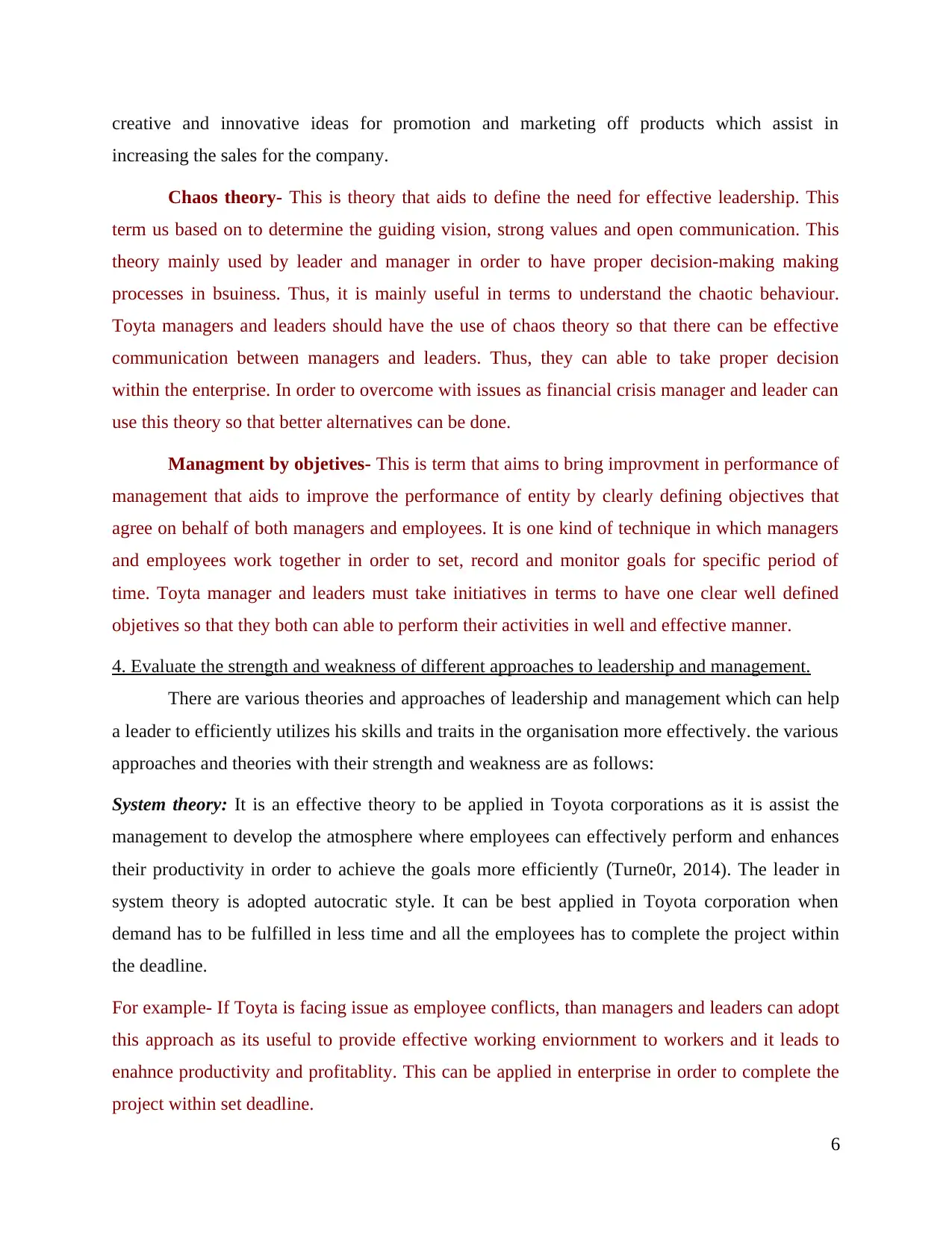
creative and innovative ideas for promotion and marketing off products which assist in
increasing the sales for the company.
Chaos theory- This is theory that aids to define the need for effective leadership. This
term us based on to determine the guiding vision, strong values and open communication. This
theory mainly used by leader and manager in order to have proper decision-making making
processes in bsuiness. Thus, it is mainly useful in terms to understand the chaotic behaviour.
Toyta managers and leaders should have the use of chaos theory so that there can be effective
communication between managers and leaders. Thus, they can able to take proper decision
within the enterprise. In order to overcome with issues as financial crisis manager and leader can
use this theory so that better alternatives can be done.
Managment by objetives- This is term that aims to bring improvment in performance of
management that aids to improve the performance of entity by clearly defining objectives that
agree on behalf of both managers and employees. It is one kind of technique in which managers
and employees work together in order to set, record and monitor goals for specific period of
time. Toyta manager and leaders must take initiatives in terms to have one clear well defined
objetives so that they both can able to perform their activities in well and effective manner.
4. Evaluate the strength and weakness of different approaches to leadership and management.
There are various theories and approaches of leadership and management which can help
a leader to efficiently utilizes his skills and traits in the organisation more effectively. the various
approaches and theories with their strength and weakness are as follows:
System theory: It is an effective theory to be applied in Toyota corporations as it is assist the
management to develop the atmosphere where employees can effectively perform and enhances
their productivity in order to achieve the goals more efficiently (Turne0r, 2014). The leader in
system theory is adopted autocratic style. It can be best applied in Toyota corporation when
demand has to be fulfilled in less time and all the employees has to complete the project within
the deadline.
For example- If Toyta is facing issue as employee conflicts, than managers and leaders can adopt
this approach as its useful to provide effective working enviornment to workers and it leads to
enahnce productivity and profitablity. This can be applied in enterprise in order to complete the
project within set deadline.
6
increasing the sales for the company.
Chaos theory- This is theory that aids to define the need for effective leadership. This
term us based on to determine the guiding vision, strong values and open communication. This
theory mainly used by leader and manager in order to have proper decision-making making
processes in bsuiness. Thus, it is mainly useful in terms to understand the chaotic behaviour.
Toyta managers and leaders should have the use of chaos theory so that there can be effective
communication between managers and leaders. Thus, they can able to take proper decision
within the enterprise. In order to overcome with issues as financial crisis manager and leader can
use this theory so that better alternatives can be done.
Managment by objetives- This is term that aims to bring improvment in performance of
management that aids to improve the performance of entity by clearly defining objectives that
agree on behalf of both managers and employees. It is one kind of technique in which managers
and employees work together in order to set, record and monitor goals for specific period of
time. Toyta manager and leaders must take initiatives in terms to have one clear well defined
objetives so that they both can able to perform their activities in well and effective manner.
4. Evaluate the strength and weakness of different approaches to leadership and management.
There are various theories and approaches of leadership and management which can help
a leader to efficiently utilizes his skills and traits in the organisation more effectively. the various
approaches and theories with their strength and weakness are as follows:
System theory: It is an effective theory to be applied in Toyota corporations as it is assist the
management to develop the atmosphere where employees can effectively perform and enhances
their productivity in order to achieve the goals more efficiently (Turne0r, 2014). The leader in
system theory is adopted autocratic style. It can be best applied in Toyota corporation when
demand has to be fulfilled in less time and all the employees has to complete the project within
the deadline.
For example- If Toyta is facing issue as employee conflicts, than managers and leaders can adopt
this approach as its useful to provide effective working enviornment to workers and it leads to
enahnce productivity and profitablity. This can be applied in enterprise in order to complete the
project within set deadline.
6
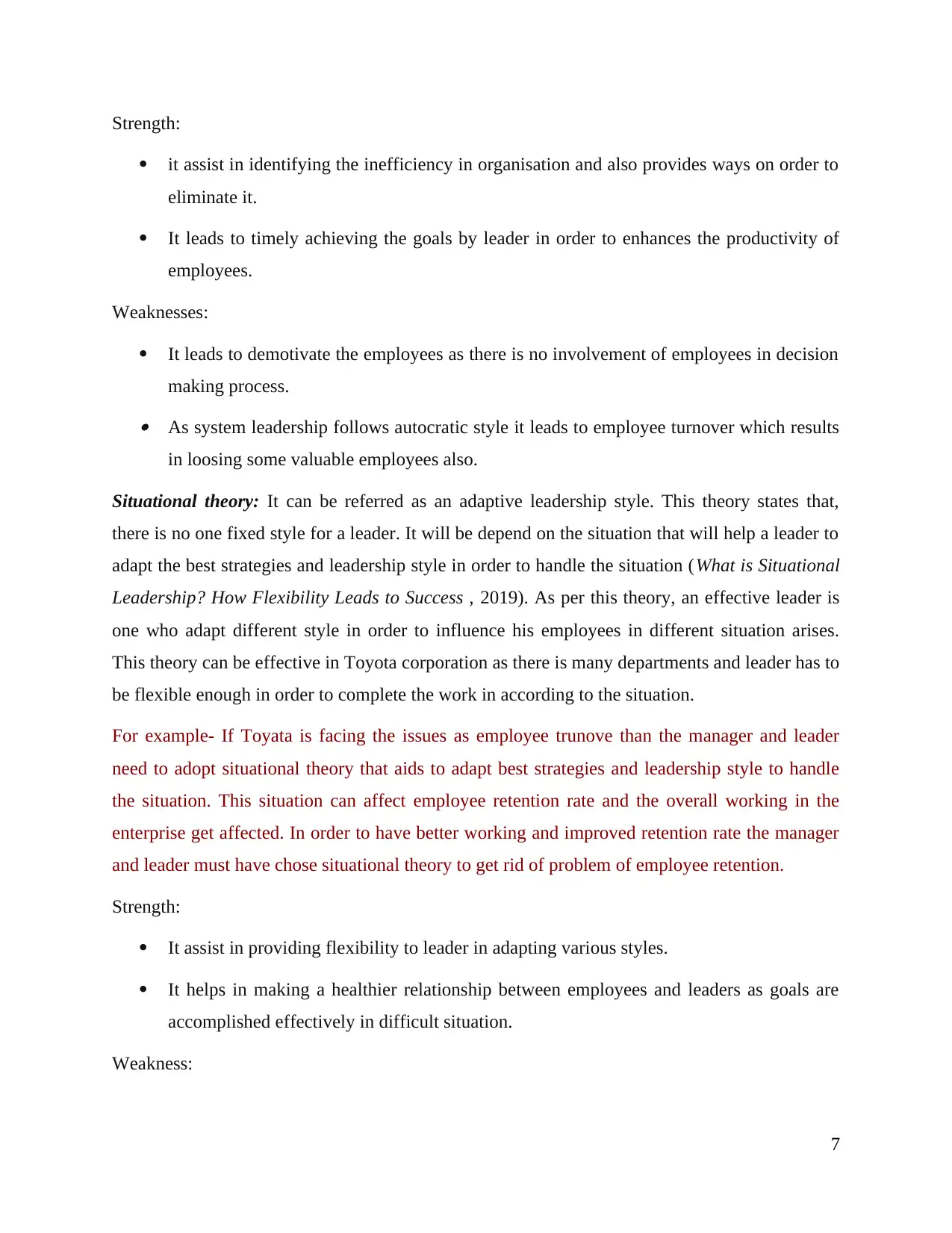
Strength:
it assist in identifying the inefficiency in organisation and also provides ways on order to
eliminate it.
It leads to timely achieving the goals by leader in order to enhances the productivity of
employees.
Weaknesses:
It leads to demotivate the employees as there is no involvement of employees in decision
making process. As system leadership follows autocratic style it leads to employee turnover which results
in loosing some valuable employees also.
Situational theory: It can be referred as an adaptive leadership style. This theory states that,
there is no one fixed style for a leader. It will be depend on the situation that will help a leader to
adapt the best strategies and leadership style in order to handle the situation (What is Situational
Leadership? How Flexibility Leads to Success , 2019). As per this theory, an effective leader is
one who adapt different style in order to influence his employees in different situation arises.
This theory can be effective in Toyota corporation as there is many departments and leader has to
be flexible enough in order to complete the work in according to the situation.
For example- If Toyata is facing the issues as employee trunove than the manager and leader
need to adopt situational theory that aids to adapt best strategies and leadership style to handle
the situation. This situation can affect employee retention rate and the overall working in the
enterprise get affected. In order to have better working and improved retention rate the manager
and leader must have chose situational theory to get rid of problem of employee retention.
Strength:
It assist in providing flexibility to leader in adapting various styles.
It helps in making a healthier relationship between employees and leaders as goals are
accomplished effectively in difficult situation.
Weakness:
7
it assist in identifying the inefficiency in organisation and also provides ways on order to
eliminate it.
It leads to timely achieving the goals by leader in order to enhances the productivity of
employees.
Weaknesses:
It leads to demotivate the employees as there is no involvement of employees in decision
making process. As system leadership follows autocratic style it leads to employee turnover which results
in loosing some valuable employees also.
Situational theory: It can be referred as an adaptive leadership style. This theory states that,
there is no one fixed style for a leader. It will be depend on the situation that will help a leader to
adapt the best strategies and leadership style in order to handle the situation (What is Situational
Leadership? How Flexibility Leads to Success , 2019). As per this theory, an effective leader is
one who adapt different style in order to influence his employees in different situation arises.
This theory can be effective in Toyota corporation as there is many departments and leader has to
be flexible enough in order to complete the work in according to the situation.
For example- If Toyata is facing the issues as employee trunove than the manager and leader
need to adopt situational theory that aids to adapt best strategies and leadership style to handle
the situation. This situation can affect employee retention rate and the overall working in the
enterprise get affected. In order to have better working and improved retention rate the manager
and leader must have chose situational theory to get rid of problem of employee retention.
Strength:
It assist in providing flexibility to leader in adapting various styles.
It helps in making a healthier relationship between employees and leaders as goals are
accomplished effectively in difficult situation.
Weakness:
7

Situational leadership relies on telling rather than listening for the leader which leads to
affect the employees performance. It does not leads to focus a leader on long-term goals.
Contingency theory: This theory sates that, there is no one leadership style for a leader.
As per this theory, a leader will best choose his style ass per the change in situation in company
(Gopee and Galloway, 2013). This theory is effective for a leader in Toyota in choosing the best
that will help in him effectively handles the changing situation in company in attaining the
efficiency in best way possible. It is effective in Toyota when there is an urgent task that has has
to be fulfilled in a given time and all the department has to follow leader's instruction.
Strength:
It assist in in giving emphasis on the leadership style and situation at the same time.
It assist in achieving flexibility as there is no particular theory has to be applied.
Weakness:
As per this approach, leader has to choose a theory and style as per the situation, which
provides lack of structure for a leader.
It is complex approach and defects from lack of creditability.
Through this theories, it can be concluded that leadership and management has different
perceptive and to work as per the situation. It can be said that leadership style is very effective to
be applied in Toyota corporation. It can be recommanded that manager and leader should opt for
situational leadership which is an effective way in order to encourage the employees and
motivate them to perform better as per the different situation.
For example- At the time of financial crisis, the entity need to go for contingency approach so
that better response and step can be taken in order to deal with it. By performing the each activity
in better manner and to deal woth each situation the Toyta manager and leader must adopt it.
5. Conclusion of how leader and manager impact on enterprise working and recommend for
future improvement.
Hereby, it can be concluded that manager and leader both are crucial components and
they take various initiatives in order to develop the better working to firm. Thus, manager and
8
affect the employees performance. It does not leads to focus a leader on long-term goals.
Contingency theory: This theory sates that, there is no one leadership style for a leader.
As per this theory, a leader will best choose his style ass per the change in situation in company
(Gopee and Galloway, 2013). This theory is effective for a leader in Toyota in choosing the best
that will help in him effectively handles the changing situation in company in attaining the
efficiency in best way possible. It is effective in Toyota when there is an urgent task that has has
to be fulfilled in a given time and all the department has to follow leader's instruction.
Strength:
It assist in in giving emphasis on the leadership style and situation at the same time.
It assist in achieving flexibility as there is no particular theory has to be applied.
Weakness:
As per this approach, leader has to choose a theory and style as per the situation, which
provides lack of structure for a leader.
It is complex approach and defects from lack of creditability.
Through this theories, it can be concluded that leadership and management has different
perceptive and to work as per the situation. It can be said that leadership style is very effective to
be applied in Toyota corporation. It can be recommanded that manager and leader should opt for
situational leadership which is an effective way in order to encourage the employees and
motivate them to perform better as per the different situation.
For example- At the time of financial crisis, the entity need to go for contingency approach so
that better response and step can be taken in order to deal with it. By performing the each activity
in better manner and to deal woth each situation the Toyta manager and leader must adopt it.
5. Conclusion of how leader and manager impact on enterprise working and recommend for
future improvement.
Hereby, it can be concluded that manager and leader both are crucial components and
they take various initiatives in order to develop the better working to firm. Thus, manager and
8
Secure Best Marks with AI Grader
Need help grading? Try our AI Grader for instant feedback on your assignments.
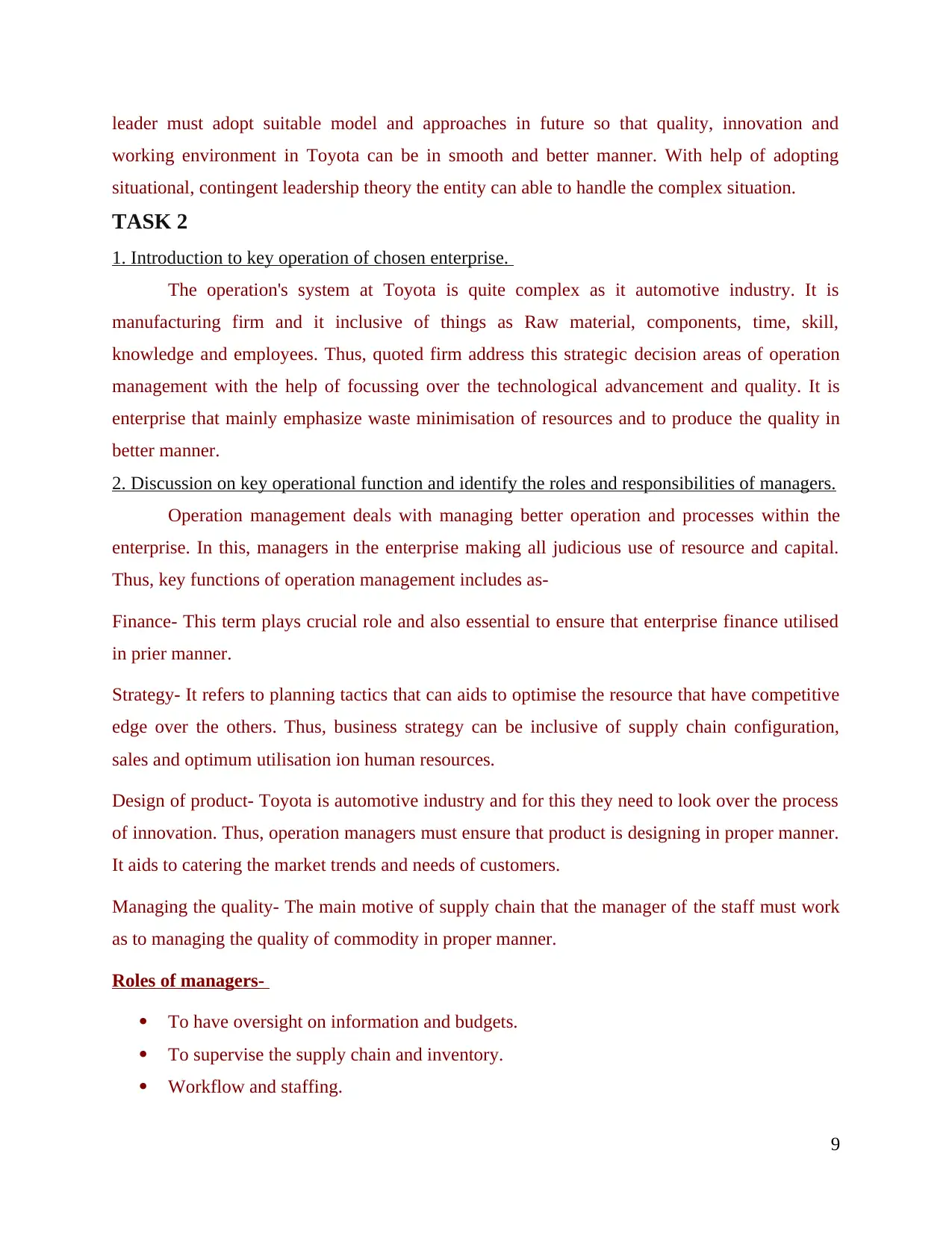
leader must adopt suitable model and approaches in future so that quality, innovation and
working environment in Toyota can be in smooth and better manner. With help of adopting
situational, contingent leadership theory the entity can able to handle the complex situation.
TASK 2
1. Introduction to key operation of chosen enterprise.
The operation's system at Toyota is quite complex as it automotive industry. It is
manufacturing firm and it inclusive of things as Raw material, components, time, skill,
knowledge and employees. Thus, quoted firm address this strategic decision areas of operation
management with the help of focussing over the technological advancement and quality. It is
enterprise that mainly emphasize waste minimisation of resources and to produce the quality in
better manner.
2. Discussion on key operational function and identify the roles and responsibilities of managers.
Operation management deals with managing better operation and processes within the
enterprise. In this, managers in the enterprise making all judicious use of resource and capital.
Thus, key functions of operation management includes as-
Finance- This term plays crucial role and also essential to ensure that enterprise finance utilised
in prier manner.
Strategy- It refers to planning tactics that can aids to optimise the resource that have competitive
edge over the others. Thus, business strategy can be inclusive of supply chain configuration,
sales and optimum utilisation ion human resources.
Design of product- Toyota is automotive industry and for this they need to look over the process
of innovation. Thus, operation managers must ensure that product is designing in proper manner.
It aids to catering the market trends and needs of customers.
Managing the quality- The main motive of supply chain that the manager of the staff must work
as to managing the quality of commodity in proper manner.
Roles of managers-
To have oversight on information and budgets.
To supervise the supply chain and inventory.
Workflow and staffing.
9
working environment in Toyota can be in smooth and better manner. With help of adopting
situational, contingent leadership theory the entity can able to handle the complex situation.
TASK 2
1. Introduction to key operation of chosen enterprise.
The operation's system at Toyota is quite complex as it automotive industry. It is
manufacturing firm and it inclusive of things as Raw material, components, time, skill,
knowledge and employees. Thus, quoted firm address this strategic decision areas of operation
management with the help of focussing over the technological advancement and quality. It is
enterprise that mainly emphasize waste minimisation of resources and to produce the quality in
better manner.
2. Discussion on key operational function and identify the roles and responsibilities of managers.
Operation management deals with managing better operation and processes within the
enterprise. In this, managers in the enterprise making all judicious use of resource and capital.
Thus, key functions of operation management includes as-
Finance- This term plays crucial role and also essential to ensure that enterprise finance utilised
in prier manner.
Strategy- It refers to planning tactics that can aids to optimise the resource that have competitive
edge over the others. Thus, business strategy can be inclusive of supply chain configuration,
sales and optimum utilisation ion human resources.
Design of product- Toyota is automotive industry and for this they need to look over the process
of innovation. Thus, operation managers must ensure that product is designing in proper manner.
It aids to catering the market trends and needs of customers.
Managing the quality- The main motive of supply chain that the manager of the staff must work
as to managing the quality of commodity in proper manner.
Roles of managers-
To have oversight on information and budgets.
To supervise the supply chain and inventory.
Workflow and staffing.
9
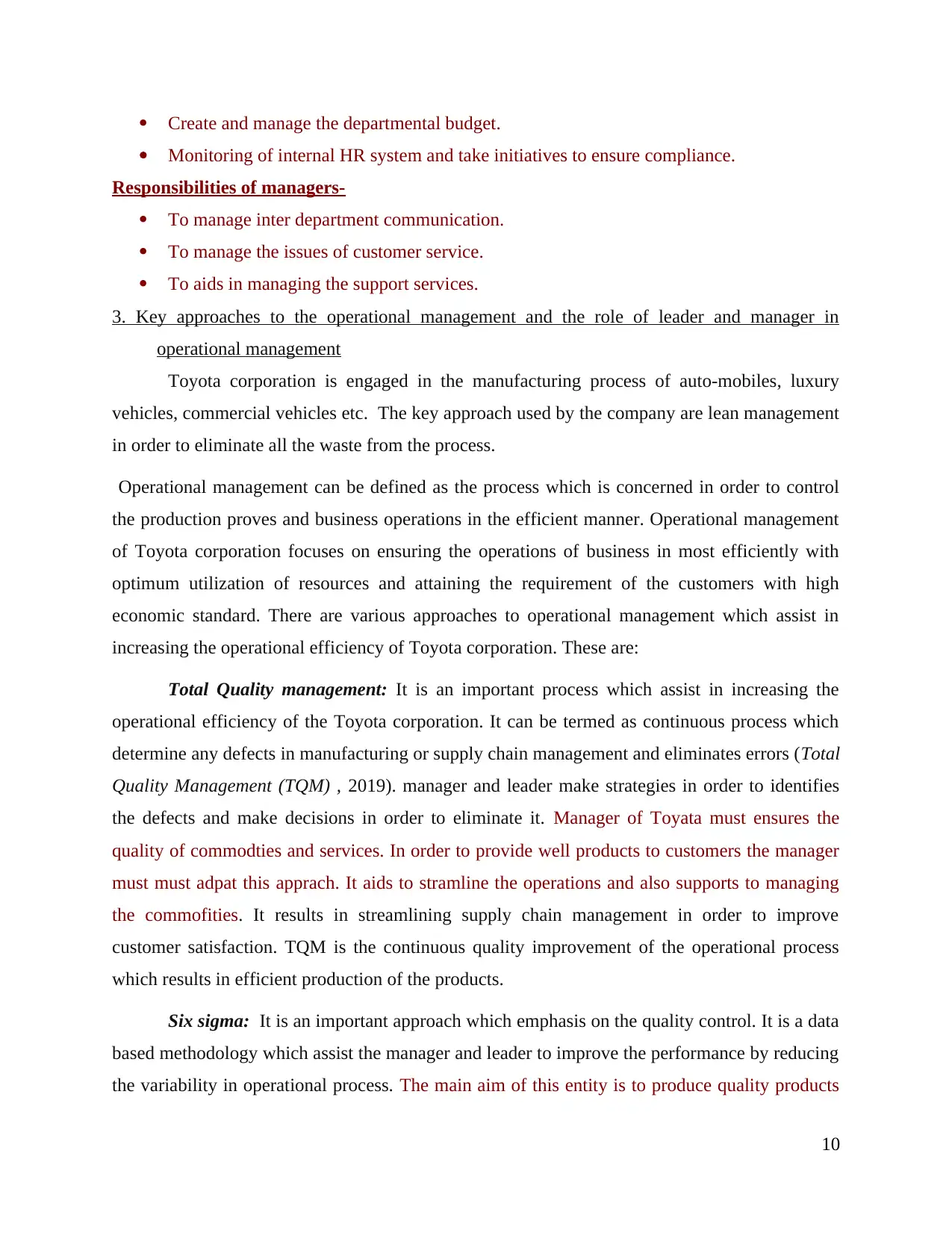
Create and manage the departmental budget.
Monitoring of internal HR system and take initiatives to ensure compliance.
Responsibilities of managers-
To manage inter department communication.
To manage the issues of customer service.
To aids in managing the support services.
3. Key approaches to the operational management and the role of leader and manager in
operational management
Toyota corporation is engaged in the manufacturing process of auto-mobiles, luxury
vehicles, commercial vehicles etc. The key approach used by the company are lean management
in order to eliminate all the waste from the process.
Operational management can be defined as the process which is concerned in order to control
the production proves and business operations in the efficient manner. Operational management
of Toyota corporation focuses on ensuring the operations of business in most efficiently with
optimum utilization of resources and attaining the requirement of the customers with high
economic standard. There are various approaches to operational management which assist in
increasing the operational efficiency of Toyota corporation. These are:
Total Quality management: It is an important process which assist in increasing the
operational efficiency of the Toyota corporation. It can be termed as continuous process which
determine any defects in manufacturing or supply chain management and eliminates errors (Total
Quality Management (TQM) , 2019). manager and leader make strategies in order to identifies
the defects and make decisions in order to eliminate it. Manager of Toyata must ensures the
quality of commodties and services. In order to provide well products to customers the manager
must must adpat this apprach. It aids to stramline the operations and also supports to managing
the commofities. It results in streamlining supply chain management in order to improve
customer satisfaction. TQM is the continuous quality improvement of the operational process
which results in efficient production of the products.
Six sigma: It is an important approach which emphasis on the quality control. It is a data
based methodology which assist the manager and leader to improve the performance by reducing
the variability in operational process. The main aim of this entity is to produce quality products
10
Monitoring of internal HR system and take initiatives to ensure compliance.
Responsibilities of managers-
To manage inter department communication.
To manage the issues of customer service.
To aids in managing the support services.
3. Key approaches to the operational management and the role of leader and manager in
operational management
Toyota corporation is engaged in the manufacturing process of auto-mobiles, luxury
vehicles, commercial vehicles etc. The key approach used by the company are lean management
in order to eliminate all the waste from the process.
Operational management can be defined as the process which is concerned in order to control
the production proves and business operations in the efficient manner. Operational management
of Toyota corporation focuses on ensuring the operations of business in most efficiently with
optimum utilization of resources and attaining the requirement of the customers with high
economic standard. There are various approaches to operational management which assist in
increasing the operational efficiency of Toyota corporation. These are:
Total Quality management: It is an important process which assist in increasing the
operational efficiency of the Toyota corporation. It can be termed as continuous process which
determine any defects in manufacturing or supply chain management and eliminates errors (Total
Quality Management (TQM) , 2019). manager and leader make strategies in order to identifies
the defects and make decisions in order to eliminate it. Manager of Toyata must ensures the
quality of commodties and services. In order to provide well products to customers the manager
must must adpat this apprach. It aids to stramline the operations and also supports to managing
the commofities. It results in streamlining supply chain management in order to improve
customer satisfaction. TQM is the continuous quality improvement of the operational process
which results in efficient production of the products.
Six sigma: It is an important approach which emphasis on the quality control. It is a data
based methodology which assist the manager and leader to improve the performance by reducing
the variability in operational process. The main aim of this entity is to produce quality products
10
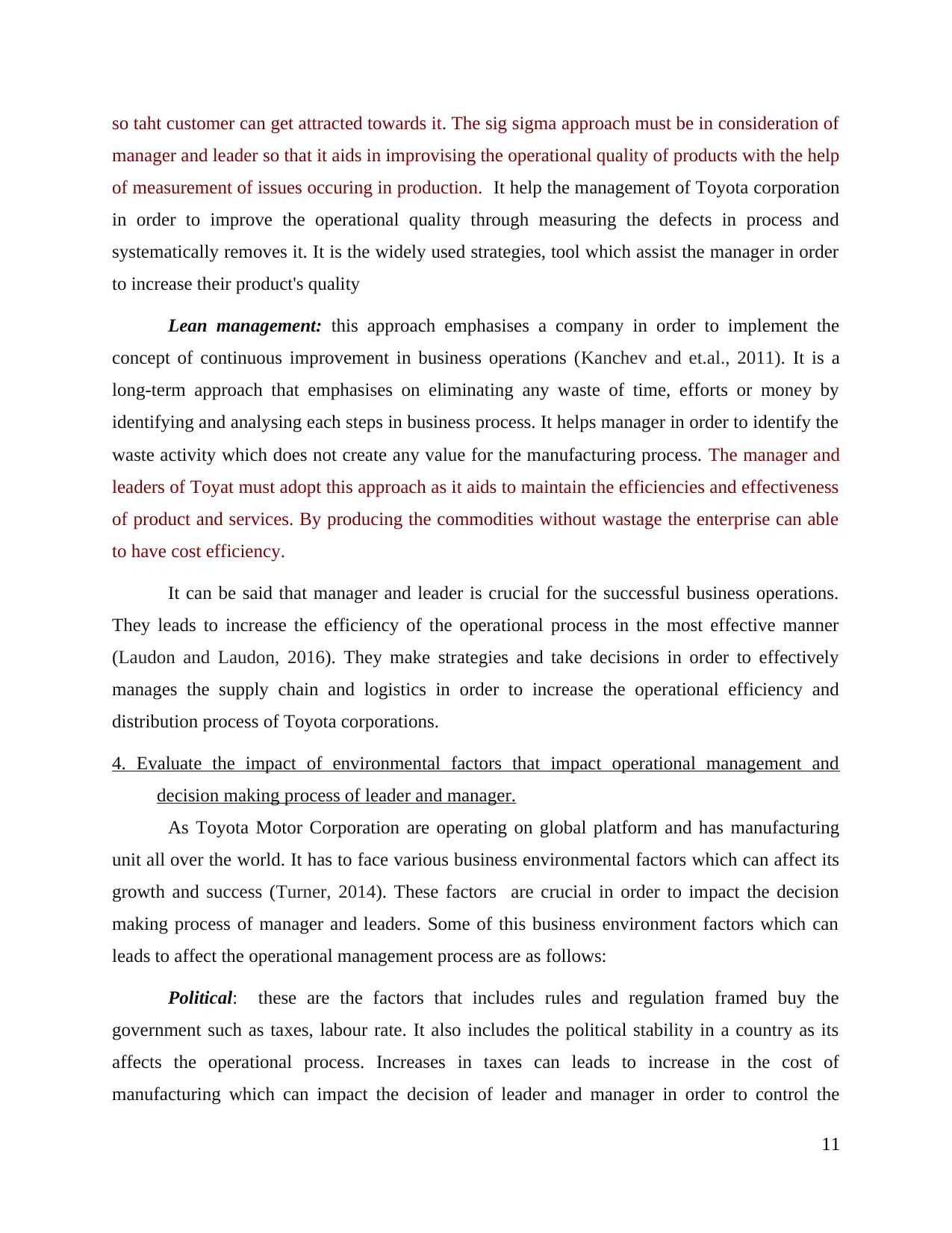
so taht customer can get attracted towards it. The sig sigma approach must be in consideration of
manager and leader so that it aids in improvising the operational quality of products with the help
of measurement of issues occuring in production. It help the management of Toyota corporation
in order to improve the operational quality through measuring the defects in process and
systematically removes it. It is the widely used strategies, tool which assist the manager in order
to increase their product's quality
Lean management: this approach emphasises a company in order to implement the
concept of continuous improvement in business operations (Kanchev and et.al., 2011). It is a
long-term approach that emphasises on eliminating any waste of time, efforts or money by
identifying and analysing each steps in business process. It helps manager in order to identify the
waste activity which does not create any value for the manufacturing process. The manager and
leaders of Toyat must adopt this approach as it aids to maintain the efficiencies and effectiveness
of product and services. By producing the commodities without wastage the enterprise can able
to have cost efficiency.
It can be said that manager and leader is crucial for the successful business operations.
They leads to increase the efficiency of the operational process in the most effective manner
(Laudon and Laudon, 2016). They make strategies and take decisions in order to effectively
manages the supply chain and logistics in order to increase the operational efficiency and
distribution process of Toyota corporations.
4. Evaluate the impact of environmental factors that impact operational management and
decision making process of leader and manager.
As Toyota Motor Corporation are operating on global platform and has manufacturing
unit all over the world. It has to face various business environmental factors which can affect its
growth and success (Turner, 2014). These factors are crucial in order to impact the decision
making process of manager and leaders. Some of this business environment factors which can
leads to affect the operational management process are as follows:
Political: these are the factors that includes rules and regulation framed buy the
government such as taxes, labour rate. It also includes the political stability in a country as its
affects the operational process. Increases in taxes can leads to increase in the cost of
manufacturing which can impact the decision of leader and manager in order to control the
11
manager and leader so that it aids in improvising the operational quality of products with the help
of measurement of issues occuring in production. It help the management of Toyota corporation
in order to improve the operational quality through measuring the defects in process and
systematically removes it. It is the widely used strategies, tool which assist the manager in order
to increase their product's quality
Lean management: this approach emphasises a company in order to implement the
concept of continuous improvement in business operations (Kanchev and et.al., 2011). It is a
long-term approach that emphasises on eliminating any waste of time, efforts or money by
identifying and analysing each steps in business process. It helps manager in order to identify the
waste activity which does not create any value for the manufacturing process. The manager and
leaders of Toyat must adopt this approach as it aids to maintain the efficiencies and effectiveness
of product and services. By producing the commodities without wastage the enterprise can able
to have cost efficiency.
It can be said that manager and leader is crucial for the successful business operations.
They leads to increase the efficiency of the operational process in the most effective manner
(Laudon and Laudon, 2016). They make strategies and take decisions in order to effectively
manages the supply chain and logistics in order to increase the operational efficiency and
distribution process of Toyota corporations.
4. Evaluate the impact of environmental factors that impact operational management and
decision making process of leader and manager.
As Toyota Motor Corporation are operating on global platform and has manufacturing
unit all over the world. It has to face various business environmental factors which can affect its
growth and success (Turner, 2014). These factors are crucial in order to impact the decision
making process of manager and leaders. Some of this business environment factors which can
leads to affect the operational management process are as follows:
Political: these are the factors that includes rules and regulation framed buy the
government such as taxes, labour rate. It also includes the political stability in a country as its
affects the operational process. Increases in taxes can leads to increase in the cost of
manufacturing which can impact the decision of leader and manager in order to control the
11
Paraphrase This Document
Need a fresh take? Get an instant paraphrase of this document with our AI Paraphraser
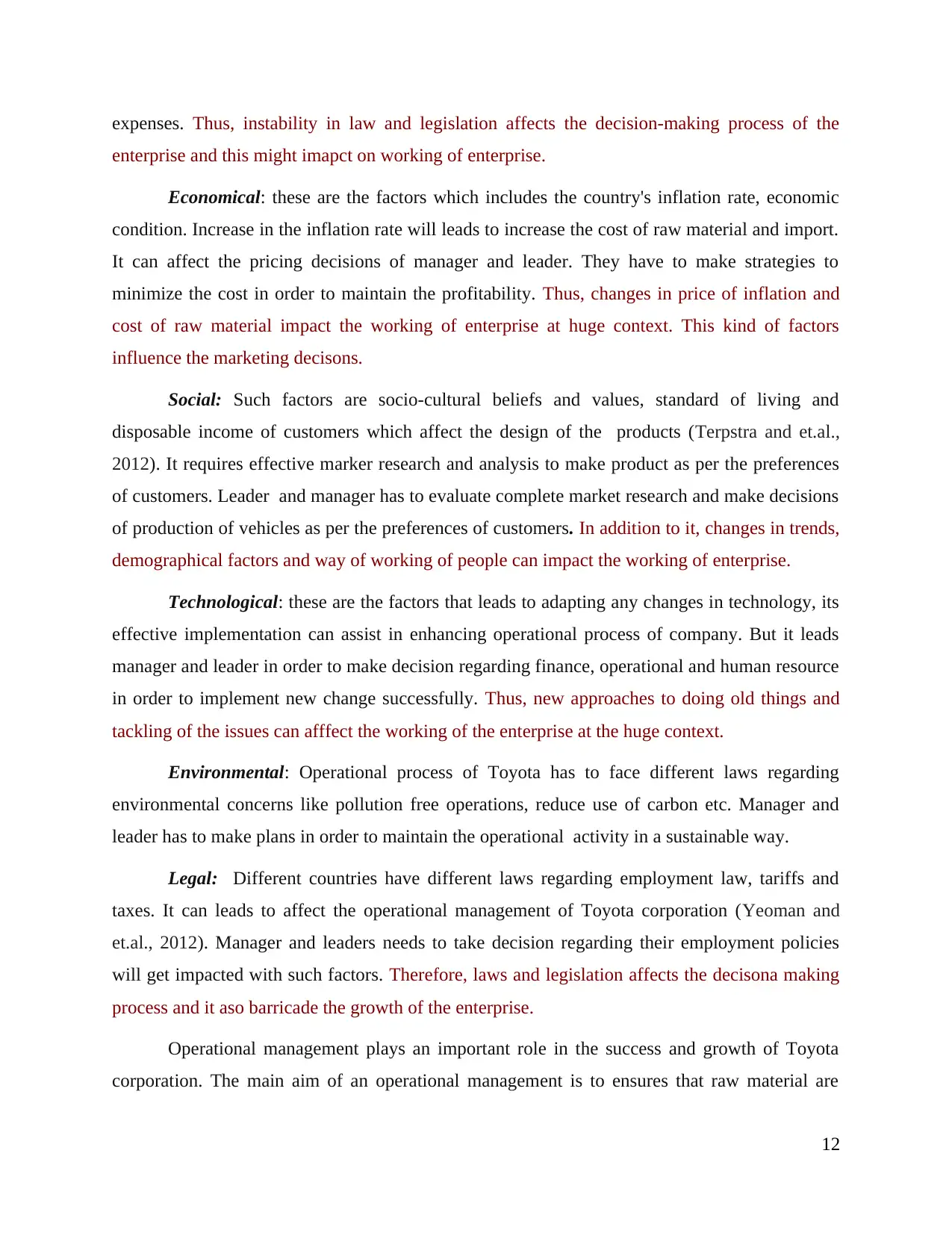
expenses. Thus, instability in law and legislation affects the decision-making process of the
enterprise and this might imapct on working of enterprise.
Economical: these are the factors which includes the country's inflation rate, economic
condition. Increase in the inflation rate will leads to increase the cost of raw material and import.
It can affect the pricing decisions of manager and leader. They have to make strategies to
minimize the cost in order to maintain the profitability. Thus, changes in price of inflation and
cost of raw material impact the working of enterprise at huge context. This kind of factors
influence the marketing decisons.
Social: Such factors are socio-cultural beliefs and values, standard of living and
disposable income of customers which affect the design of the products (Terpstra and et.al.,
2012). It requires effective marker research and analysis to make product as per the preferences
of customers. Leader and manager has to evaluate complete market research and make decisions
of production of vehicles as per the preferences of customers. In addition to it, changes in trends,
demographical factors and way of working of people can impact the working of enterprise.
Technological: these are the factors that leads to adapting any changes in technology, its
effective implementation can assist in enhancing operational process of company. But it leads
manager and leader in order to make decision regarding finance, operational and human resource
in order to implement new change successfully. Thus, new approaches to doing old things and
tackling of the issues can afffect the working of the enterprise at the huge context.
Environmental: Operational process of Toyota has to face different laws regarding
environmental concerns like pollution free operations, reduce use of carbon etc. Manager and
leader has to make plans in order to maintain the operational activity in a sustainable way.
Legal: Different countries have different laws regarding employment law, tariffs and
taxes. It can leads to affect the operational management of Toyota corporation (Yeoman and
et.al., 2012). Manager and leaders needs to take decision regarding their employment policies
will get impacted with such factors. Therefore, laws and legislation affects the decisona making
process and it aso barricade the growth of the enterprise.
Operational management plays an important role in the success and growth of Toyota
corporation. The main aim of an operational management is to ensures that raw material are
12
enterprise and this might imapct on working of enterprise.
Economical: these are the factors which includes the country's inflation rate, economic
condition. Increase in the inflation rate will leads to increase the cost of raw material and import.
It can affect the pricing decisions of manager and leader. They have to make strategies to
minimize the cost in order to maintain the profitability. Thus, changes in price of inflation and
cost of raw material impact the working of enterprise at huge context. This kind of factors
influence the marketing decisons.
Social: Such factors are socio-cultural beliefs and values, standard of living and
disposable income of customers which affect the design of the products (Terpstra and et.al.,
2012). It requires effective marker research and analysis to make product as per the preferences
of customers. Leader and manager has to evaluate complete market research and make decisions
of production of vehicles as per the preferences of customers. In addition to it, changes in trends,
demographical factors and way of working of people can impact the working of enterprise.
Technological: these are the factors that leads to adapting any changes in technology, its
effective implementation can assist in enhancing operational process of company. But it leads
manager and leader in order to make decision regarding finance, operational and human resource
in order to implement new change successfully. Thus, new approaches to doing old things and
tackling of the issues can afffect the working of the enterprise at the huge context.
Environmental: Operational process of Toyota has to face different laws regarding
environmental concerns like pollution free operations, reduce use of carbon etc. Manager and
leader has to make plans in order to maintain the operational activity in a sustainable way.
Legal: Different countries have different laws regarding employment law, tariffs and
taxes. It can leads to affect the operational management of Toyota corporation (Yeoman and
et.al., 2012). Manager and leaders needs to take decision regarding their employment policies
will get impacted with such factors. Therefore, laws and legislation affects the decisona making
process and it aso barricade the growth of the enterprise.
Operational management plays an important role in the success and growth of Toyota
corporation. The main aim of an operational management is to ensures that raw material are
12
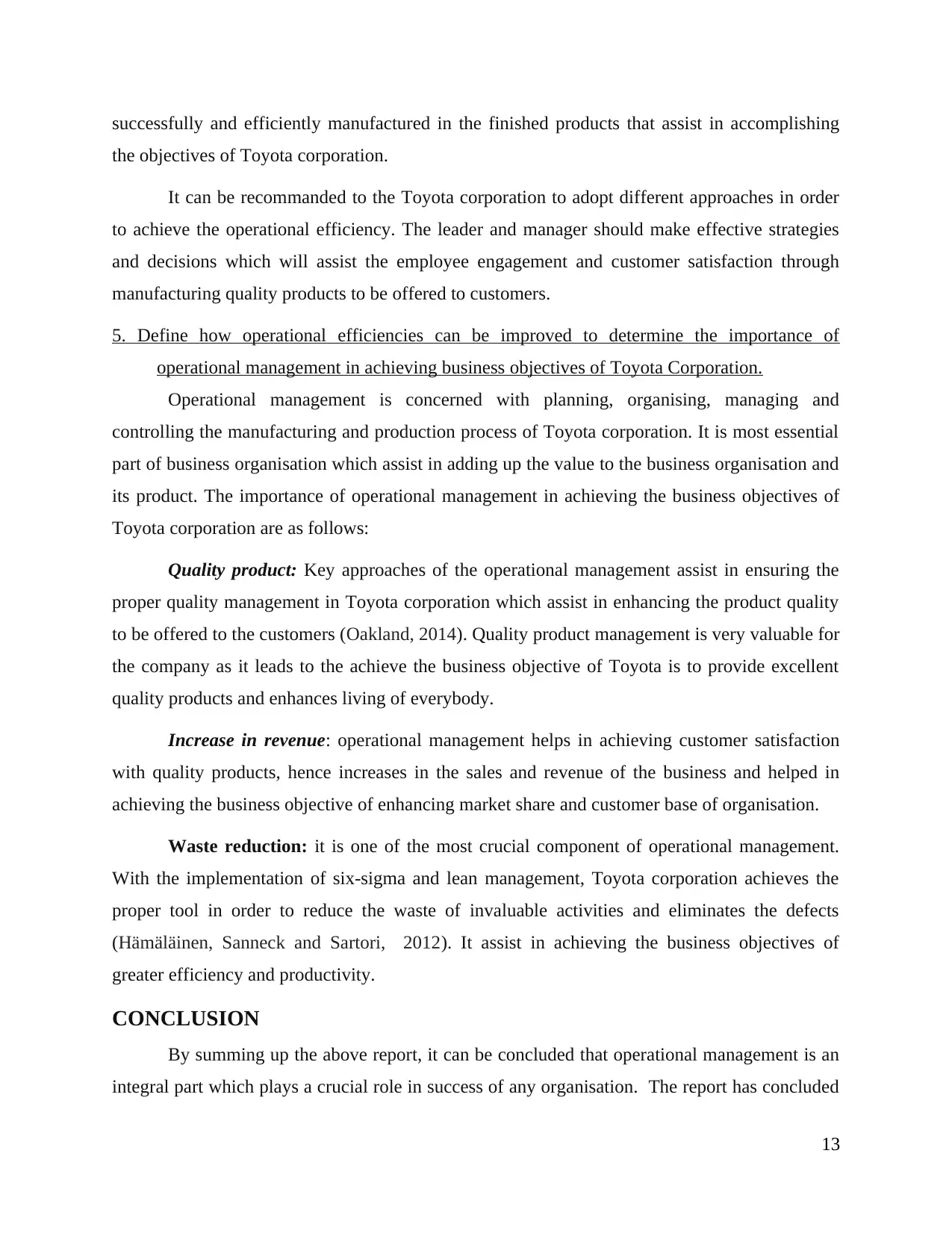
successfully and efficiently manufactured in the finished products that assist in accomplishing
the objectives of Toyota corporation.
It can be recommanded to the Toyota corporation to adopt different approaches in order
to achieve the operational efficiency. The leader and manager should make effective strategies
and decisions which will assist the employee engagement and customer satisfaction through
manufacturing quality products to be offered to customers.
5. Define how operational efficiencies can be improved to determine the importance of
operational management in achieving business objectives of Toyota Corporation.
Operational management is concerned with planning, organising, managing and
controlling the manufacturing and production process of Toyota corporation. It is most essential
part of business organisation which assist in adding up the value to the business organisation and
its product. The importance of operational management in achieving the business objectives of
Toyota corporation are as follows:
Quality product: Key approaches of the operational management assist in ensuring the
proper quality management in Toyota corporation which assist in enhancing the product quality
to be offered to the customers (Oakland, 2014). Quality product management is very valuable for
the company as it leads to the achieve the business objective of Toyota is to provide excellent
quality products and enhances living of everybody.
Increase in revenue: operational management helps in achieving customer satisfaction
with quality products, hence increases in the sales and revenue of the business and helped in
achieving the business objective of enhancing market share and customer base of organisation.
Waste reduction: it is one of the most crucial component of operational management.
With the implementation of six-sigma and lean management, Toyota corporation achieves the
proper tool in order to reduce the waste of invaluable activities and eliminates the defects
(Hämäläinen, Sanneck and Sartori, 2012). It assist in achieving the business objectives of
greater efficiency and productivity.
CONCLUSION
By summing up the above report, it can be concluded that operational management is an
integral part which plays a crucial role in success of any organisation. The report has concluded
13
the objectives of Toyota corporation.
It can be recommanded to the Toyota corporation to adopt different approaches in order
to achieve the operational efficiency. The leader and manager should make effective strategies
and decisions which will assist the employee engagement and customer satisfaction through
manufacturing quality products to be offered to customers.
5. Define how operational efficiencies can be improved to determine the importance of
operational management in achieving business objectives of Toyota Corporation.
Operational management is concerned with planning, organising, managing and
controlling the manufacturing and production process of Toyota corporation. It is most essential
part of business organisation which assist in adding up the value to the business organisation and
its product. The importance of operational management in achieving the business objectives of
Toyota corporation are as follows:
Quality product: Key approaches of the operational management assist in ensuring the
proper quality management in Toyota corporation which assist in enhancing the product quality
to be offered to the customers (Oakland, 2014). Quality product management is very valuable for
the company as it leads to the achieve the business objective of Toyota is to provide excellent
quality products and enhances living of everybody.
Increase in revenue: operational management helps in achieving customer satisfaction
with quality products, hence increases in the sales and revenue of the business and helped in
achieving the business objective of enhancing market share and customer base of organisation.
Waste reduction: it is one of the most crucial component of operational management.
With the implementation of six-sigma and lean management, Toyota corporation achieves the
proper tool in order to reduce the waste of invaluable activities and eliminates the defects
(Hämäläinen, Sanneck and Sartori, 2012). It assist in achieving the business objectives of
greater efficiency and productivity.
CONCLUSION
By summing up the above report, it can be concluded that operational management is an
integral part which plays a crucial role in success of any organisation. The report has concluded
13
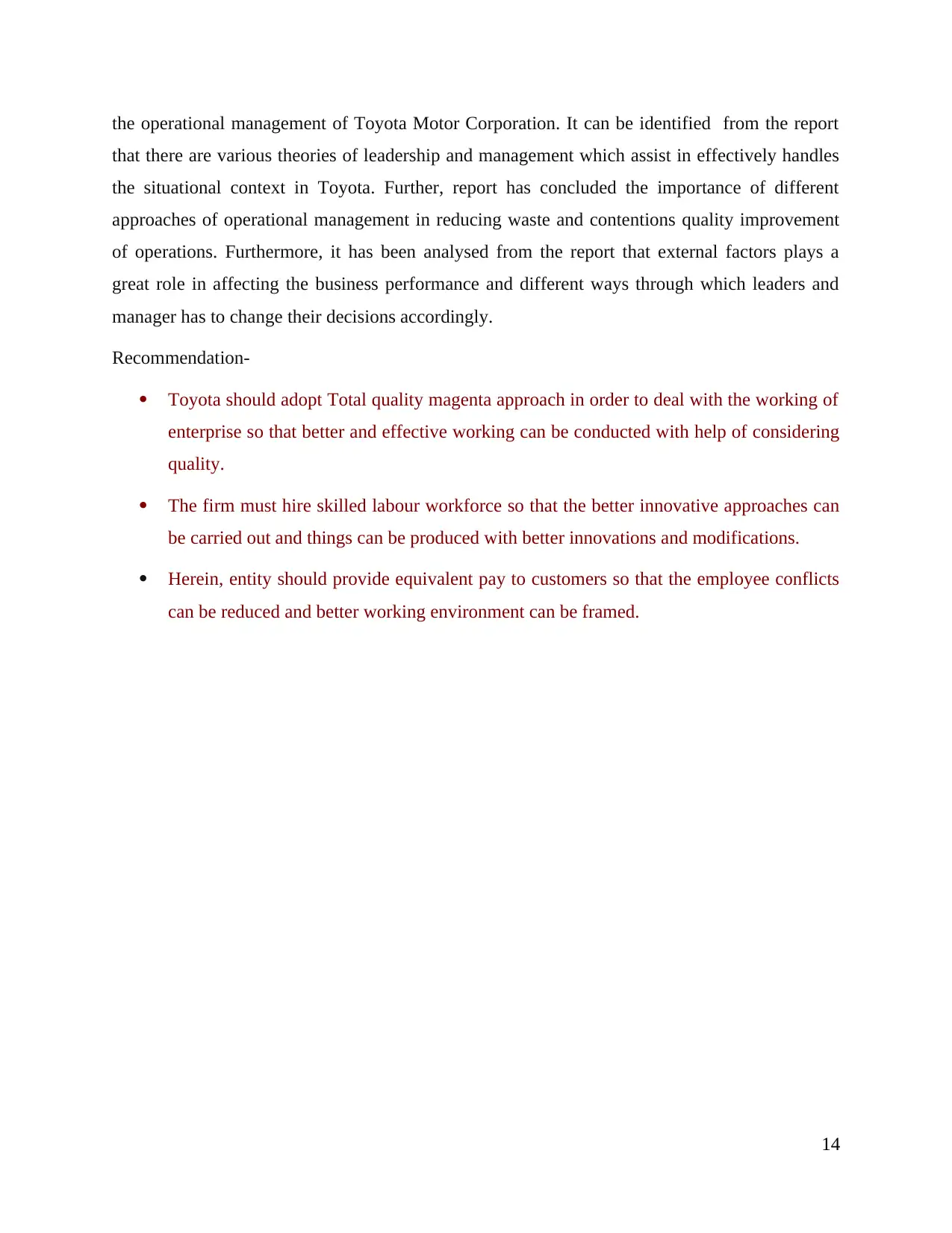
the operational management of Toyota Motor Corporation. It can be identified from the report
that there are various theories of leadership and management which assist in effectively handles
the situational context in Toyota. Further, report has concluded the importance of different
approaches of operational management in reducing waste and contentions quality improvement
of operations. Furthermore, it has been analysed from the report that external factors plays a
great role in affecting the business performance and different ways through which leaders and
manager has to change their decisions accordingly.
Recommendation-
Toyota should adopt Total quality magenta approach in order to deal with the working of
enterprise so that better and effective working can be conducted with help of considering
quality.
The firm must hire skilled labour workforce so that the better innovative approaches can
be carried out and things can be produced with better innovations and modifications.
Herein, entity should provide equivalent pay to customers so that the employee conflicts
can be reduced and better working environment can be framed.
14
that there are various theories of leadership and management which assist in effectively handles
the situational context in Toyota. Further, report has concluded the importance of different
approaches of operational management in reducing waste and contentions quality improvement
of operations. Furthermore, it has been analysed from the report that external factors plays a
great role in affecting the business performance and different ways through which leaders and
manager has to change their decisions accordingly.
Recommendation-
Toyota should adopt Total quality magenta approach in order to deal with the working of
enterprise so that better and effective working can be conducted with help of considering
quality.
The firm must hire skilled labour workforce so that the better innovative approaches can
be carried out and things can be produced with better innovations and modifications.
Herein, entity should provide equivalent pay to customers so that the employee conflicts
can be reduced and better working environment can be framed.
14
Secure Best Marks with AI Grader
Need help grading? Try our AI Grader for instant feedback on your assignments.

REFERENCES
Books and Journals
Champy, J., 2018. Reengineering Management The Mandate for new Leadership. Harper
Collins.
Goetsch, D. L. and Davis, S. B., 2014. Quality management for organizational excellence. Upper
Saddle River, NJ: pearson.
Gopee, N. and Galloway, J., 2013. Leadership and management in healthcare. Sage.
Hämäläinen, S., Sanneck, H. and Sartori, C. eds., 2012. LTE self-organising networks (SON):
network management automation for operational efficiency. John Wiley & Sons.
Johnston, M. W. and Marshall, G. W., 2013. Sales force management: Leadership, innovation,
technology. Routledge.
Kanchev, H and et.al., 2011. Energy management and operational planning of a microgrid with a
PV-based active generator for smart grid applications. IEEE transactions on industrial
electronics. 58(10). pp.4583-4592.
Laudon, K. C. and Laudon, J. P., 2016. Management information system. Pearson Education
India.
McCaffery, P., 2018. The higher education manager's handbook: effective leadership and
management in universities and colleges. Routledge.
Oakland, J. S., 2014. Total quality management and operational excellence: text with cases.
Routledge.
Renz, D. O., 2016. The Jossey-Bass handbook of nonprofit leadership and management. John
Wiley & Sons.
Stacey, R., 2012. Tools and techniques of leadership and management: Meeting the challenge of
complexity. Routledge.
Terpstra, T. and et.al., 2012. Towards a realtime Twitter analysis during crises for operational
crisis management (pp. 1-9). Burnaby: Simon Fraser University.
Turner, J. R., 2014. Handbook of project-based management(Vol. 92). New York, NY:
McGraw-hill.
Turner, J. R., 2014. Handbook of project-based management(Vol. 92). New York, NY:
McGraw-hill.
Vaccaro, I. G. and et.al., 2012. Management innovation and leadership: The moderating role of
organizational size. Journal of Management Studies. 49(1). pp.28-51.
Yeoman, I and et.al., 2012. Festival and events management. Routledge.
Online
Total Quality Management (TQM) . 2019 [ONLINE] Available
through:<https://www.toolshero.com/quality-management/total-quality-management-
tqm/>.
15
Books and Journals
Champy, J., 2018. Reengineering Management The Mandate for new Leadership. Harper
Collins.
Goetsch, D. L. and Davis, S. B., 2014. Quality management for organizational excellence. Upper
Saddle River, NJ: pearson.
Gopee, N. and Galloway, J., 2013. Leadership and management in healthcare. Sage.
Hämäläinen, S., Sanneck, H. and Sartori, C. eds., 2012. LTE self-organising networks (SON):
network management automation for operational efficiency. John Wiley & Sons.
Johnston, M. W. and Marshall, G. W., 2013. Sales force management: Leadership, innovation,
technology. Routledge.
Kanchev, H and et.al., 2011. Energy management and operational planning of a microgrid with a
PV-based active generator for smart grid applications. IEEE transactions on industrial
electronics. 58(10). pp.4583-4592.
Laudon, K. C. and Laudon, J. P., 2016. Management information system. Pearson Education
India.
McCaffery, P., 2018. The higher education manager's handbook: effective leadership and
management in universities and colleges. Routledge.
Oakland, J. S., 2014. Total quality management and operational excellence: text with cases.
Routledge.
Renz, D. O., 2016. The Jossey-Bass handbook of nonprofit leadership and management. John
Wiley & Sons.
Stacey, R., 2012. Tools and techniques of leadership and management: Meeting the challenge of
complexity. Routledge.
Terpstra, T. and et.al., 2012. Towards a realtime Twitter analysis during crises for operational
crisis management (pp. 1-9). Burnaby: Simon Fraser University.
Turner, J. R., 2014. Handbook of project-based management(Vol. 92). New York, NY:
McGraw-hill.
Turner, J. R., 2014. Handbook of project-based management(Vol. 92). New York, NY:
McGraw-hill.
Vaccaro, I. G. and et.al., 2012. Management innovation and leadership: The moderating role of
organizational size. Journal of Management Studies. 49(1). pp.28-51.
Yeoman, I and et.al., 2012. Festival and events management. Routledge.
Online
Total Quality Management (TQM) . 2019 [ONLINE] Available
through:<https://www.toolshero.com/quality-management/total-quality-management-
tqm/>.
15
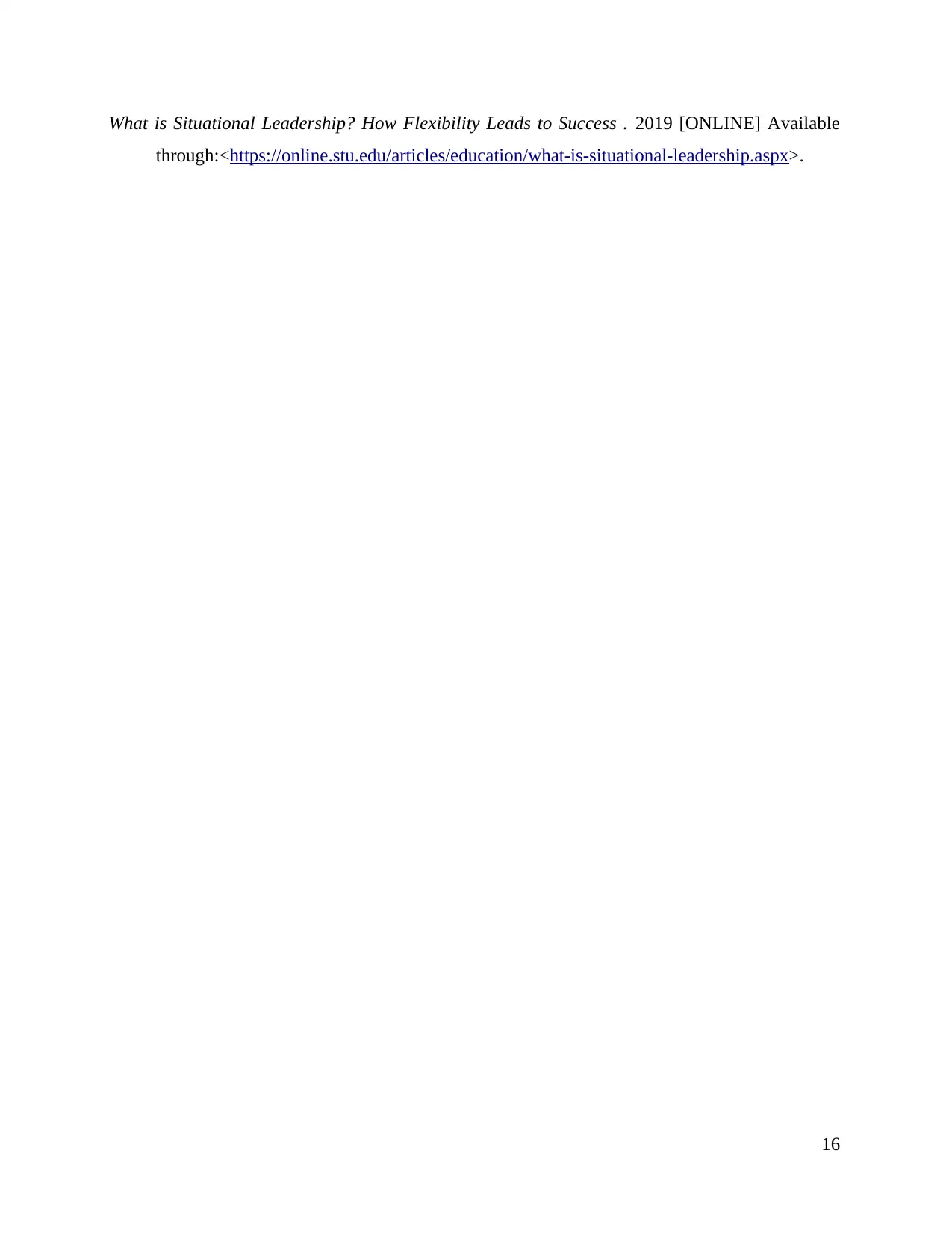
What is Situational Leadership? How Flexibility Leads to Success . 2019 [ONLINE] Available
through:<https://online.stu.edu/articles/education/what-is-situational-leadership.aspx>.
16
through:<https://online.stu.edu/articles/education/what-is-situational-leadership.aspx>.
16
1 out of 18
Related Documents
Your All-in-One AI-Powered Toolkit for Academic Success.
+13062052269
info@desklib.com
Available 24*7 on WhatsApp / Email
![[object Object]](/_next/static/media/star-bottom.7253800d.svg)
Unlock your academic potential
© 2024 | Zucol Services PVT LTD | All rights reserved.





